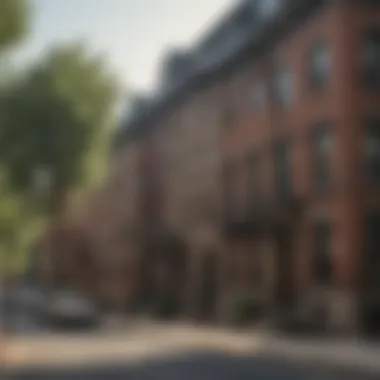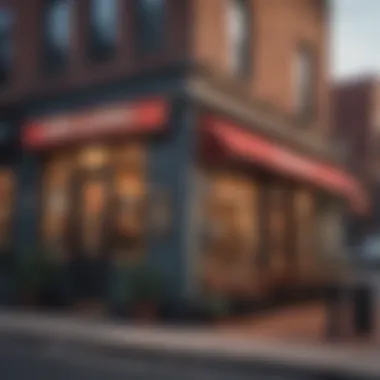Exploring Philadelphia Neighborhoods: Your Living Guide


Intro
Philadelphia, a city that wears its rich history like a favorite coat, offers a tapestry of neighborhoods, each with its unique personality and charm. From the cobblestone streets of Old City to the artistic aura of Fishtown, finding the right area to call home is much more than just choosing a spot on a map. It’s about embracing a lifestyle that resonates with personal values and aspirations.
In this guide, we’ll traverse through various aspects of living in Philadelphia by highlighting notable features like architecture, cultural richness, and local ambiance. Whether you’re moving for work, education, or simply a fresh start, understanding what each neighborhood has to offer can tilt the scales in favor of your ideal living situation. We will delve into factors like affordability and accessibility, so you can make well-rounded decisions that cater to both your preferences and your budget.
"Philadelphia is a city of neighborhoods. Each area is as different as its residents, and that's what makes it an exciting place to live."
Before digging into specifics, let’s take a look at some fabulous homes you can find in this vibrant city, as well as the unique design themes and architectural highlights that characterize each locality.
Understanding Philadelphia's Neighborhood Landscape
Understanding the neighborhood landscape of Philadelphia is pivotal for anyone looking to make this city their home. With its rich history, vibrant culture, and varying community dynamics, Philadelphia offers an array of choices that can cater to diverse lifestyles and preferences. Each neighborhood not only has its own unique character but also plays a significant role in shaping the experiences of those who live there.
Historical Overview of Philadelphia's Neighborhoods
Philadelphia's neighborhoods reflect its colonial past and industrial evolution. Founded in the early 1700s, Philadelphia was designed by William Penn to be a city that promoted tolerance and diversity. Over the centuries, neighborhoods evolved, forming enclaves based on ethnicity, profession, and social status. For instance, South Philadelphia became a hub for Italian immigrants in the late 19th century, which molded its culinary delights and communal spirit. Similarly, areas like Germantown have deep roots connected to the Quakers and abolitionist movements.
As urban development unfolded, neighborhoods faced transformations. Areas like Northern Liberties transitioned from industrial zones to artistic communities, revealing the city’s adaptability to change. Reflecting on this history is crucial for newcomers, as it offers insights into the cultural richness that each neighborhood can provide. By understanding these elements, future residents can appreciate the contributing factors that shaped their potential home.
Key Demographics of Philadelphia's Residents
Demographics play a key role in understanding the charm and appeal of different neighborhoods in Philadelphia. The city's population is notably diverse, with varied age groups, ethnic backgrounds, and economic situations across neighborhoods. For example, Center City houses a younger, professional crowd, while West Philadelphia has a vibrant mix of students, families, and established residents.
A closer look at the numbers shows:
- Age Distribution: The median age in certain areas might skew younger due to nearby universities like the University of Pennsylvania and Drexel. In contrast, parts of the Northeast, with its suburban feel, often have older residents.
- Income Levels: Income disparities are significant; affluent areas such as Rittenhouse Square showcase high living costs, while places like Kensington may offer more affordable housing but face challenges related to economic stability.
- Ethnic Diversity: Neighborhoods like South Philadelphia celebrate strong Italian heritage, while places like Fishtown reflect a more contemporary, artsy vibe that attracts a mix of newcomers from various backgrounds.
This demographic mapping is not just numbers on a page; it provides a snapshot into the daily life and community cohesiveness in these areas. Knowing the demographic trends can help individuals and families make informed choices about where they feel they would fit best.
For anyone contemplating a move or just wanting to get a real feel for the city, this understanding of Philadelphia's diverse neighborhood landscape is the first step in finding the right place to call home.
Factors to Consider When Choosing a Neighborhood
Choosing a neighborhood in Philadelphia isn’t just about picking a spot on a map; it’s about finding a place that resonates with your lifestyle, values, and ambitions. Whether you are relocating, seeking a new home, or simply exploring, understanding the different factors at play can provide you with an upper hand. Each neighborhood has its own flavor, making the decision both exciting and challenging. The following aspects stand out as crucial when narrowing down your options to find that perfect nook in the City of Brotherly Love.
Cost of Living and Housing Market Trends
Philadelphia’s housing market is as diverse as its neighborhoods. Understanding the cost of living can profoundly affect your quality of life and financial well-being. Some areas, such as Center City, often carry a hefty price tag due to their central location and amenities. In contrast, neighborhoods like North Philadelphia might offer more affordable options, appealing to those who want the city experience without breaking the bank.
When considering the market trends, keep an eye on the upward or downward shifts in home prices, which can hint at future desirability. Riding the market wave often means more than just affordability—it can set the stage for potential equity growth down the line. A localized search can help you uncover hidden gems. As they say, "you've got to know the lay of the land."
Accessibility and Transportation Options
Philadelphia boasts a robust public transportation system, yet accessibility varies across its neighborhoods. Proximity to SEPTA lines or regional trains can be a game-changer for daily commuters. In neighborhoods like West Philadelphia, residents often rely on public transit, while those living in Fishtown might find bike paths and walkable streets more convenient.
Understanding how well-connected an area is can shape your daily routine. If your ideal day involves zipping around town or getting to the suburbs quickly, access to major roadways or transit lines is essential. As they often say, “Time is money.” Save it by being strategic about where you plant your roots.
Quality of Schools and Educational Institutions


For families or individuals invested in lifelong learning, education quality takes center stage. Philadelphia is home to several acclaimed public, private, and charter schools. Neighborhoods like South Philadelphia have reputable institutions that cater to diverse populations, particularly in areas with strong community ties.
The presence of colleges and universities, such as the University of Pennsylvania and Temple University, can also influence local education dynamics, potentially enhancing community engagement and cultural vibrancy. No doubt, choosing a neighborhood with quality educational institutions can set kiddos and adults alike up for success.
Local Amenities and Services
When weighing neighborhood choices, local amenities play a substantial role in daily convenience and lifestyle satisfaction. From grocery stores to parks, cafes to gyms, the availability of these facilities can weigh heavily on your decision. Imagine living in a place where your morning coffee shop is just a stroll away.
Consider what matters most to you. Do you want green parks for weekend picnics? Or maybe you prefer vibrant nightlife with restaurants and bars nearby? Having easy access to services like healthcare facilities also promotesthat peace of mind. A quick walk to essentials is invaluable in the hustle and bustle of city life.
Community Vibe and Social Environment
Lastly, the neighborhood’s social environment and overall vibe should not be underestimated. Each area in Philadelphia possesses a distinct character, shaped by its residents and cultural dynamics. For instance, South Philadelphia is known for its warm, community-focused atmosphere, boasting local festivals and strong neighborhood ties. On the other hand, neighborhoods like Rittenhouse Square are often perceived as upscale, with a more fast-paced social scene.
Assessing community engagement—through local events, meetups, or community boards—can give you insights into how welcoming and vibrant a neighborhood is. Finding a place where you feel a sense of belonging can turn a house into a home. As you weigh all these factors, keep in mind: “It’s not just about living; it’s about thriving.”
"Finding the right neighborhood is like finding a comfortable shoe; it should fit you just right."
Exploring Notable Philadelphia Neighborhoods
Philadelphia's neighborhoods offer a tapestry of experiences, each with its flavor and character. Understanding the different locales is crucial for anyone considering a move to the city. This section aims to illuminate some of the most notable neighborhoods in Philadelphia, highlighting essential attributes that could influence your decision-making as you search for the right place to call home.
Here's what you can expect to learn about each neighborhood:
- Distinctive features and community vibes
- Access to amenities that shape day-to-day life
- Opportunities for cultural engagement and connection
By exploring these neighborhood hotspots, readers will gain insight into what makes each area unique, aiding in both practical decisions and lifestyle considerations.
Center City: The Heart of Philadelphia
Lifestyle and Amenities
Center City is often viewed as the epicenter of Philadelphia living. This bustling area brims with life and activity. The lifestyle here showcases an urban appeal, surrounded by shops, dining spots, and entertainment venues. You can find everything from high-rise apartments to boutique hotels.
The amenities available are nothing short of remarkable. There's a plethora of parks, gyms, and public spaces, making it an attractive option for people looking to balance work and leisure. The key characteristic of Center City is its accessibility; everything is within walking distance or a short public transportation ride. However, living in this vibrant locale does come at a premium, so it's wise to keep your budget in check.
Connection to Culture
When we talk about Center City, we can't ignore its rich cultural fabric. Museums, theaters, and galleries dot the landscape. The Kimmel Center for the Performing Arts and the Philadelphia Museum of Art are just a stone's throw away. This deep-rooted connection to culture attracts residents who cherish arts and history.
Center City is beneficial for those who seek cultural enrichment, allowing them to engage with events and activities regularly. Yet it also might feel overwhelming for newcomers as the vibrant social scene can be quite dense.
West Philadelphia: A Blend of Cultures
Educational Opportunities
West Philadelphia stands out, notably for its educational institutions. It is home to renowned schools and universities, including the University of Pennsylvania and Drexel University. These educational hubs foster a lively atmosphere and create myriad opportunities for students and lifelong learners alike.
The juxtaposition of academic resources with local initiatives enriches the community. For those looking to immerse themselves in a neighborhood with thriving educational prospects going beyond just facilities, West Philadelphia is certainly a wise choice.
Community Spirit


One of the most compelling aspects of West Philadelphia is its community spirit. Residents tend to come together, engaging in neighborhood initiatives and events. This sense of belonging makes West Philadelphia appealing to newcomers looking to find a supportive environment.
However, like many neighborhoods, it is not all rosy. The community spirit sometimes contrasts with urban challenges, leading to varying experiences depending on one’s address within West.
South Philadelphia: Rich Tradition and Community
Culinary Scene
South Philadelphia is renowned for its culinary scene, drawing in food lovers from all corners. The area is especially famous for its Italian roots, housing countless eateries offering mouthwatering dishes. Whether it’s a classic cheesesteak from Pat’s or a delightful pastry from the local bakeries, there’s no shortage of delightful options.
The key characteristic here is the sense of tradition. Many of these restaurants have been family-owned for generations, offering an authentic taste of history. However, it might be wise for some to tread carefully, as some spots can be tourist-heavy, leading to fluctuating quality.
Events and Festivals
In South Philadelphia, the local events calendar is packed year-round. Community gatherings, parades, and food festivals mark the calendar, showcasing the rich traditions that residents hold dear. The Italian Market Festival, for instance, brings in crowds to celebrate the area’s heritage.
This active social calendar benefits families and individuals looking to embrace local culture. Still, the vibrant activity may not suit those seeking peace and quiet, especially during festival seasons.
North Philadelphia: Emerging Hotspot
Arts and Culture Revival
North Philadelphia has undergone a significant transformation in recent years, positioning itself as an emerging arts and culture hotspot. The neighborhood is home to a mix of hip galleries, experimental theaters, and music venues. The diversity in artistic expression is notable, making it an exciting place to live for those interested in the arts.
The revitalization efforts have breathed new life into abandoned spaces, turning them into hubs of creativity. While this renaissance is promising, it's essential to note that the area has yet to fully heal from its past challenges, leading to mixed experiences for residents.
Affordable Housing Options
In a city known for its rising costs, North Philadelphia often presents more affordable housing options compared to areas like Center City. This possible affordability can be quite appealing, especially for young professionals and families looking for budget-friendly choices along with access to urban life.
However, it's crucial to conduct thorough research. The pricing differences can reflect broader socio-economic factors at play, making it important to assess the neighborhood dynamics before deciding.
Fishtown: Urban Revival and Trendsetting
Art and Music Scene
Fishtown has transitioned into a cultural gem in Philadelphia, often buzzing with artistic vibes. The neighborhood is well-known for its art scene, featuring murals, studios, and a variety of creative spaces. Live music venues and independent theaters thrive here, turning Fishtown into a space where new artistic trends are birthed.
The local art scene serves as a magnet for millennials and visitors alike, establishing Fishtown as a trendsetting location. Nevertheless, keep in mind that as the area becomes trendy, the rising costs of living can deter some potential newcomers.
Cafés and Dining
Fishtown is equally celebrated for its eclectic range of cafés and dining establishments. From cozy coffee spots to gourmet restaurants, there's something to satisfy every palate. The atmosphere is often casual and welcoming, ideal for meeting friends or unwinding after a long day.
This diverse culinary landscape makes it a popular choice for foodies and young professionals. Be cautious, however; some venues are known for lengthy wait times, especially during peak hours.
Rittenhouse Square: Luxury Living
Green Spaces
Rittenhouse Square stands out for its impressive green spaces. The centerpiece, Rittenhouse Square Park, offers a serene escape in the midst of urban life. It often serves as a gathering place for community events, yoga classes, and casual meetups.


The abundant greenery found throughout the neighborhood significantly contributes to its allure, attracting individuals who value outdoor spaces. On the flip side, the accessibility of these spaces may also draw crowds, creating a bustling vibe that is not for everyone.
High-End Shopping
When it comes to shopping, Rittenhouse Square doesn’t fall short. The area boasts high-end shopping options ranging from designer boutiques to upscale department stores. This luxury shopping experience caters to affluent residents and those seeking to indulge in premium products.
While this shopping district enhances the neighborhood�’s appeal, it may discourage budget-conscious residents. Still, the prestige associated with Rittenhouse Square is something worth considering for potential homeowners.
The Role of Community Resources
Community resources play a fundamental role in shaping the quality of life for residents in Philadelphia. Whether you are a lifelong local or a newcomer finding your feet, understanding these resources can substantially influence your living experience. Community initiatives, libraries, and cultural centers bring more than just services; they foster connections and enhance civic pride, making neighborhoods feel more like home.
Having access to robust community organizations means residents can engage in local activities that reflect their interests and values. These resources often provide a support network for families, skills development opportunities, and avenues for civic engagement, which can greatly enhance one's living experience in any part of the city.
Community Organizations and Initiatives
Philadelphia is marred by a vibrant array of community organizations dedicated to various causes—from social justice to environmental stewardship. These groups are steadfast in their goal to uplift communities, providing residents with avenues to contribute and connect.
Here are some of the focal points these organizations tend to address:
- Neighborhood Safety: Organizations often focus on enhancing safety measures and promoting community policing initiatives. Residents can engage in neighborhood watch programs, enabling them to take an active role in keeping their streets secure.
- Economic Development: Many local initiatives aim to stimulate small business growth, bringing jobs and vibrancy to neighborhoods. Co-operative ventures or small-business incubators can be crucial for aspiring entrepreneurs.
- Youth Programs: There is a definite emphasis on creating programs for the youth, whether through mentorship initiatives, after-school programs, or sports leagues. These not only provide recreational outlets but also elevate educational outcomes.
These organizations pivot around the idea of collaboration. When residents get involved, they strengthen social networks and create a sense of belonging. Accessing such resources makes it easier for individuals to integrate and contribute to their communities.
Public Libraries and Cultural Centers
Public libraries and cultural centers in Philadelphia serve as gateways to knowledge, creativity, and community engagement. These places are not merely repositories of books; they are hubs for personal growth and community bonding.
Some important aspects include:
- Lifelong Learning: Libraries host numerous workshops and classes, from art to tech. Reaching for a skill is much easier with these readily available resources.
- Cultural Programming: Arts festivals, author talks, and community discussions are often organized in these centers, fostering a rich cultural tapestry. They reflect the diverse heritage of Philadelphia, inviting residents of all backgrounds to engage and share their stories.
- Safe Spaces: Libraries and cultural centers often provide welcoming environments where residents can come together and discuss pressing issues or simply enjoy each other's company. It’s about creating a local ecosystem where everyone feels valued and heard.
"A library is not a luxury but one of the necessities of life." - Henry Ward Beecher
These institutions support the fabric of the neighborhoods while also serving the practical needs of community members. When you settle into a neighborhood in Philadelphia, tap into these resources to enrich your lifestyle and build a network that can help you thrive.
Impacts of Urban Development
Urban development in Philadelphia has far-reaching consequences that greatly shape the city’s neighborhoods. With a rich historical foundation, the city has seen myriad transformations in its landscape. This evolution offers both challenges and opportunities for residents and prospective newcomers. Some key elements of urban development affect housing, amenities, cultural expressions, and the overall quality of life in various areas.
In particular, understanding gentrification gives insight into how cities change. As neighborhoods get revitalized, their character and make-up can dramatically shift, often leading to increased property values and a surge in new residents. Yet, this change can also displace longtime locals. Thus, finding the balance between development and retaining community essence becomes crucial. Couples that with the importance of cultural identity, urban development's impacts can be rather nuanced.
"Urban development is not just about bricks and mortar; it's about people and their stories."
Gentrification and Its Effects
Gentrification is one of the most talked-about effects of urban development. When looking at Philadelphia, neighborhoods like Fishtown and Northern Liberties serve as prime examples of this phenomenon. As artists and young professionals flock to these areas for their affordability and vibrant culture, businesses and dining spots inevitably follow. The previously modest properties get jazzed up, and with that comes a higher cost of living.
While this inflow brings about modern cafés, art galleries, and improved public spaces, it also produces a squeeze on the lower-income residents. Many communities experience a transformation that isn’t entirely beneficial. Long-established shops and local customers like to see small monuments of their history fade into the background as larger chains enter the scene. It raises the question of whether development erases the very identity these neighborhoods were built upon.
Keeping Cultural Identity Amid Change
Despite the shifts seen through gentrification, some neighborhoods in Philadelphia strive to maintain their unique cultural identities. Community efforts play a significant role here. For instance, by encouraging local entrepreneurs to start businesses or support cultural events, residents can keep their traditions alive. Community gardens, annual festivals, and art shows represent local heritage, offering both existing residents and newcomers a taste of the richness that defines Philadelphia.
In neighborhoods like South Philadelphia, local Italian markets or diverse cultural festivals celebrate traditions that have thrived for generations. It's vital to acknowledge that advancement can coexist with honoring the past, allowing for a blend of new and old.
When locals band together and emphasize a sense of place, they not only resist uniformity but also carve out spaces where history and modernity go hand in hand. This aspect of urban development specifically highlights the importance of a community that feels deeply rooted in its soil, despite the shifting tides.







